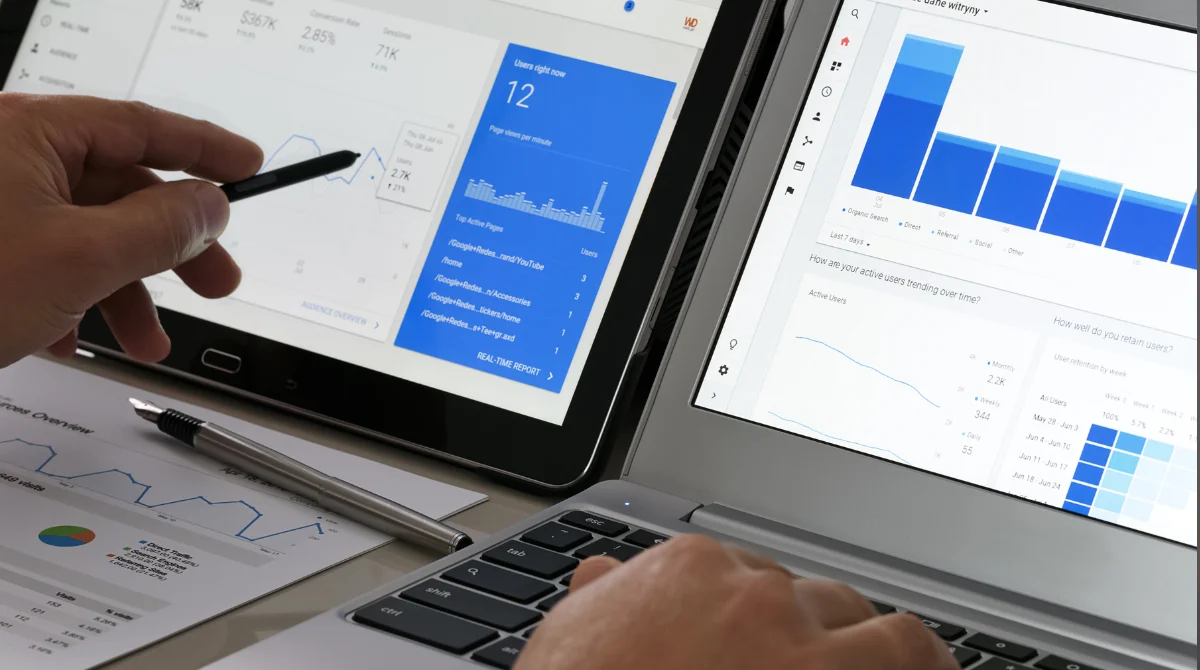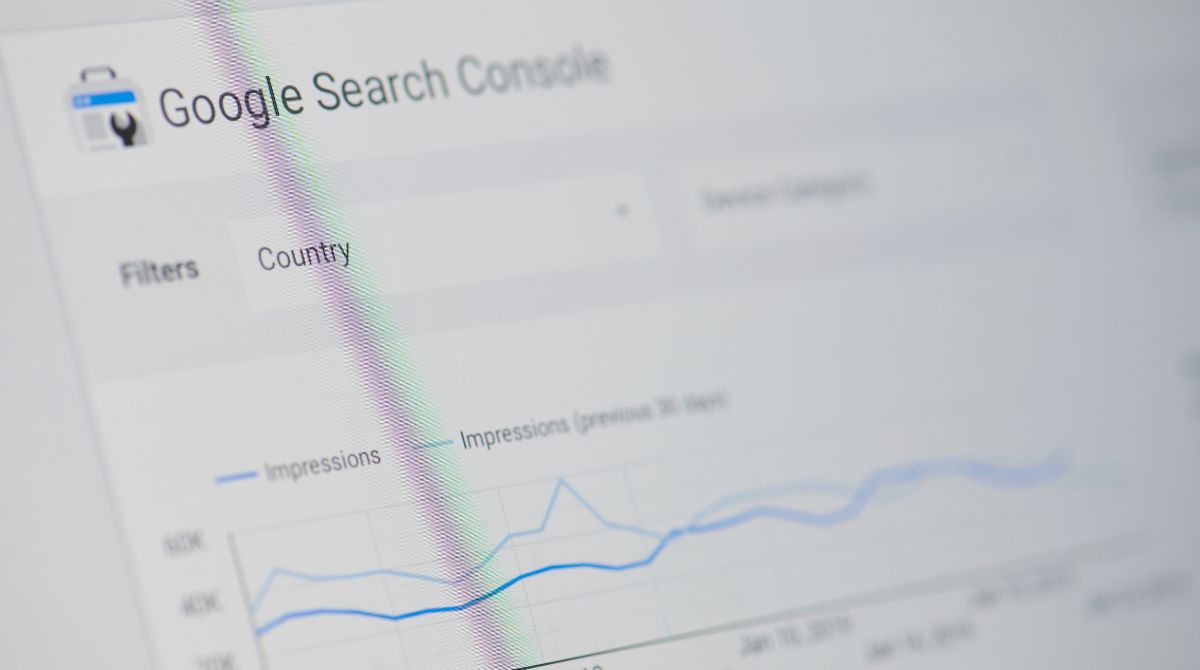Understanding the performance of your website and the ways users engage with it presents a thrilling chance to realise its complete capability. Armed with the appropriate insights, you can distinctly pinpoint what is functioning effectively, discover areas for enhancement, and devise a strategy for successfully expanding your online visibility.
Imagine the advantages of possessing data-informed transparency—understanding that your website is tailored to draw in and keep clients, your material is connecting with your target demographic, and every choice you make is supported by dependable data. The result? Efficient use of time and resources, opportunities embraced, and an advantage over your competitors in the market.
This is where Google Analytics excels. It’s a robust platform that offers crucial insights into website traffic, user interactions, and overall effectiveness. By utilising Google Analytics, you can make more informed choices, improve the user experience, and reach your business objectives. In this article, we will delve into what Google Analytics is, why it’s important, and how it can yield optimal outcomes for your website.
What Is Google Analytics?
Google Analytics is a smart tool from Google which helps to figure out how the website is doing and to learn about the visitors. It is a free tool for anyone using a Google account as part of Google’s marketing tools. Google Analytics will tell whether a big company or a small shop, but whatever you have, you will get the information you need to make smart choices about your online presence.
This service helps to:
- Keep an eye on and study how well the website is doing
- Get detailed information about the visitors
- Find out where most of the visitors are coming from
- Check how well the marketing efforts are working
- Watch how many people are completing goals or making purchases
- Look at how users are interacting with the site
- Get details about the age, location, and other facts about the visitors
For small and medium-sized businesses, Google Analytics is especially useful. This will give them important information about how the customers behave and can help them better in the marketing or get more visitors to the site and keep them returning.
How does Google Analytics work?
Google Analytics works by using a complex system to gather and process data. This system has several important parts:
Setup and Implementation
So, the process begins with signing up for a special Analytics account apart from the regular Google account. Then, users must add a small piece of JavaScript code (known as a page tag) to every website page. The data collection code below is the basis for all the rest.
Data Collection Process
The tracking code gathers different kinds of anonymous data about visitors, such as:
- Page interactions and navigation patterns
- Browser information and language settings
- Device and operating system details
- Traffic sources and referral information
- User engagement metrics
Data Processing and Storage
After the data is collected, it is:
- Sent to Google’s servers
- Analysed and combined
- Turned into useful reports
- Saved in a secure database where it can’t be changed
- Accessible through different reporting tools
The page tag acts like a tracker, collecting visitor details using cookies. Remember that if users have turned off cookies, they won’t be tracked, which might make the data less complete.
Google Analytics features
Google Analytics provides a wide range of tools to help businesses better understand the customers and data:
- Automated Insights
- Uses machine learning to find important information automatically
- Predicts future trends and behaviours
- Shows the full path customers take before making a purchase
- Creates reports automatically
2. Data Collection and Management
- Strong tools for gathering data
- Easy-to-use controls for managing data
- Options to collect specific data needed
- Advanced tools to filter and organise data
3. Analysis Tools
- Tracks and shows how customers move through the website or app
- Identifies overlapping groups of customers
- Lets to create custom groups of customers for analysis
- Analyses how different channels (like ads or social media) contribute to sales
4. Reporting Capabilities
- Tracks customer activity in real-time
- Measures how engaged customers are with the content
- Tracks revenue and sales performance
- Shows where the customers are coming from (e.g., ads, search engines)
- Allows to create custom reports tailored to the needs
Important Google Analytics metrics
In Google Analytics, metrics are numbers that help businesses see how well the website is doing. These metrics provide actionable insights to evaluate progress, identify areas for improvement, and inform strategic decisions for online initiatives.
Core User Metrics
- Users
Someone who visits a website is called a user. Second, Google Analytics uses tracking codes, also known as tracking snippets, to monitor users through browsers (cookies). In the first visit to a given site, this is a ‘New User’. Anything else would constitute a “Returning User” if the same person returned later (and cookies are still in place). These numbers helps to understand how many people are coming to the site, how many are new visitors, and if you’re keeping your old visitors returning.
- Sessions
30 mins, that’s a session. It’s a way to track what the site’s user was doing in the last 30 mins. It can be visiting one page or another, clicking on links, or interacting with social media. For example, if a user goes to a homepage, looks at three product pages and goes away a minute after that, that’s one session. If the user is inactive for 30 minutes, or they return to the site from another source if they have been, then the session ends if it’s midnight. It’s useful because it lets to see how often people use the website.
- Average Session Duration
The second measure is the average time on the website during a visit. To calculate the total time of all visits, divide it by the number of visits. For instance, if the site has one thousand visits representing two thousand fifty thousand seconds, the average visit time will be fifty seconds. This number will show how interesting the content is and whether users see what they are looking for on the site.
- Pages per Session
Pages per session show the average number of pages a user looks at on one visit to the site. To get this number, just divide the whole number of pages viewed by the entire number of visits. Suppose that on the site, the page views were 5,000 and visits were 1,000; then, the number of pages per session would be 5. A higher number usually means that users like the content, and thus, they check more pages on the site.
Engagement Metrics
- Bounce Rate
The bounce rate is the percentage of visitors leaving a website after visiting only one page without doing anything else. If people come to the site, like, and then leave without clicking anything or going after other pages, this is a “bounce”. The bounce rate is extremely high (70-80%) to the point that signals it might be because a website has not met what they expected, or it’s the wrong people that you’re reaching. A high bounce rate might not be a problem on some pages, like blog posts, or it might be normal.
- Page Views
Page views are the total number of times people look at the site pages — regardless of how many times per page they might visit. This number is how much of the content is being seen. For example, if someone sees a homepage, goes kicked off to one of the product pages, returns to the homepage, and then back to another product page, you’ve had 4-page views. But it tells who is on the site most of the time and which content is the most popular.
- Unique Page Views
In contrast to ordinary page views, unique page views are all the visits to the same page across sessions. Specifically, the page counts as one if that user visited the homepage twice within the same session or two if the user visited the homepage once during that single session. This allows to show how many users visit each page, rather than the simple total of visits.
Conversion Metrics
Goal Completions
Goal completions track how often users do specific, important actions on the website. Goals can include:
- Buying something
- Filling out a contact form
- Signing up for a newsletter
- Downloading files
- Visiting certain pages
For example, if you set filling out a contact form as a goal, Google Analytics will record how many users send the form out properly. It demonstrates how well a website sets the stage for empowering users to take the actions you want.
Conversion Rate
This is how many visits of the website have gotten to take the desired action (which may be a purchase or sign-up). It’s just awareness… It’s how many visits vs. actions are completed. So you are dividing that number by how many visits. For example, if a site gets 1,000 visits and 50 completed actions, the conversion rate is 5%. It’s important because it’s an important number that tells how good the website is at turning the visitors – the visitors who are not customers or leads – into customers or leads.
Traffic Source Metrics
This measure shows where the website visitors come from, divided into different groups:
- Direct traffic (people typing a website address directly)
- Organic search (visitors from search engines like Google)
- Paid search (visitors from ads you pay for)
- Referral traffic (visitors coming from other websites)
- Social media traffic (visitors from platforms like Facebook or Twitter)
- Email marketing traffic (visitors from emails you send)
Knowing where the traffic comes from helps to improve the marketing and see which methods bring the most visitors to the site.
New vs. Returning Visitors
This measure looks at the difference between people visiting the site for the first time and those who have visited before. A good website usually has a balance of both:
- First-time visitors show that the site can bring in new people.
- Returning visitors means the content is interesting enough for people to come back.
The best balance depends on what a business wants to achieve and the industry, but keeping an eye on this measure helps to see how loyal the audience is and how well the strategies to attract visitors work.
These measures together give a full picture of how the website is doing. By understanding and regularly checking these measures, businesses can make smart choices about online plans, what content to create, and how to market themselves.
What is a Dimension in Google Analytics?
Dimensions are descriptive details that give meaning to the numbers and help organise data for better understanding. They allow to merge and group the data differently to gain insights.
Common examples of dimensions are:
- Language choices
- Types of browsers and devices
- Location (city or country)
- Device models and categories
- User details like age groups
It’s important to know how dimensions and metrics work together. Metrics give the numbers, while dimensions provide the context to understand what those numbers mean.
User Acquisition Data Vs. User Behaviour Data
| Aspect | User Acquisition Data | User Behaviour Data |
| Primary Focus | How users find and reach the website | What users do after arriving on the website |
|
Key Metrics |
|
|
|
Business Value |
|
|
|
Data Sources |
|
|
|
Analysis Goals |
|
|
|
Impact Areas |
|
|
What Is Google Analytics 4?
Google Analytics 4 (GA4), launched in October 2020, is a big step forward in analytics technology. This new version brings several important changes:
Key Improvements:
- Uses events to track data instead of sessions
- Better at measuring activity across different platforms
- Uses more advanced machine learning
- Offers stronger privacy controls and follows the rules better
- Works more closely with Google Ads
Major Features:
- Focuses on understanding customers better
- Uses advanced models to track behaviour and conversions
- Gives more control over data and how long it’s kept
- Includes built-in tools to protect privacy
- Better at predicting future trends and actions
Benefits and Limitations of Google Analytics
Before we go into the detailed benefits and limitations of Google Analytics, we must look at where it sits on the digital analytics wagon. This is the most commonly used website data-tracking tool. It’s been a while since its creation, so it’s come a long way; it now has some amazing tracking features, insights using machine learning, and detailed reporting tools. Like any tool, it has its strong points and limitations, and businesses must weigh in carefully.
Google Analytics has revolutionised how businesses decide and run digital marketing efforts. That means you can use high-level analytics tools reserved only for big companies. Organisations can learn to use it to the fullest by understanding what it does well and where it can improve, and then figure out how to close the gap in data analysis needs.
Benefits:
- Affordable: Offers a free version with lots of useful features.
- User-Friendly: Simple to use with helpful support.
- Compatibility: Works well with many other tools.
- Insights: Provides strong data analysis features.
Limitations:
- Data Reliability: Can be influenced by different factors.
- Privacy Rules: Must follow strict data protection laws.
- Technical Skills: Needs some knowledge to use effectively.
Boost Your Website with Make My Website
If you want to improve and grow your business online, you must get Google Analytics. It lets you see who visits the website and how the users behave, so you have information that can be used to make this decision and be successful smartly.
If you are interested in using Google Analytics to the fullest but don’t know where to begin, Make My Website is here to assist. We have experts on our team who are skilled at improving websites, analysing data, and creating custom digital strategies to help your business increase. We’ll take care of the complicated stuff so you can focus on building your brand. Contact us now and start improving your online presence!



















